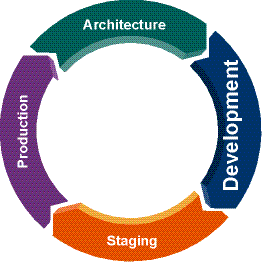Release Information
Installation Guide
Release Notes
Upgrade
Overview
Previous Versions
WebLogic Portal 10.0
WebLogic Portal 9.2
WebLogic Portal 8.1
WebLogic Portal 7.0
WebLogic Portal 4.0
Reference
What's New?
Download Documentation
Javadoc
JSP Tag Javadoc
Disc API Documentation
REST API Documentation
Solutions Catalog
Product Documentation
WebLogic Server
BEA Workshop Product Family
JRockit
AquaLogic Service Bus
More Documentation
Supported Configurations
BEA Product Supported Configurations
Supported Configurations for WebLogic Portal
System Requirements for Integrating Autonomy Search
Resources
Ask BEA
Customer Support
Dev2Dev Online
WebLogic Portal® Life Cycle - Development Phase
Following the planning, design, and initial resource creation performed in the architecture phase, you can begin application development.
In the development phase, you use the set of resources created in the architecture phase to create programmatic portal application functionality and portal user interfaces, maintaining your work in a source control system. Resources you create in the development phase may include JSPs, page flows, web services, portals, books, pages, portlets, campaigns, content selectors, placeholders, property sets, XML files, graphics, JavaScript, HTML, and Java code. (If you create EJBs, you are likely to do so in the architecture phase.) These resources you create in the development phase are file based, and when you reach the production phase the resources are most likely deployed in an enterprise archive (.ear) file. The primary tools used in this phase are source control, Workshop for WebLogic, other editors of choice, the WebLogic Portal Administration Console (for configuring database resources), and the WebLogic Portal Production Operations Tools to move database and LDAP data between staging and development, if necessary. The development phase overlaps with the staging phase. Because development code and resources are often dependent on database and security data, such as content, users, and security roles, development occurs in parallel with staging where database and security data are populated. While it is possible for developers to create database resources on their own development machines, setting up database resources in the staging environment provides a single location for all developers to share the same resources. The following guides detail development considerations within the portal life cycle: |
|
